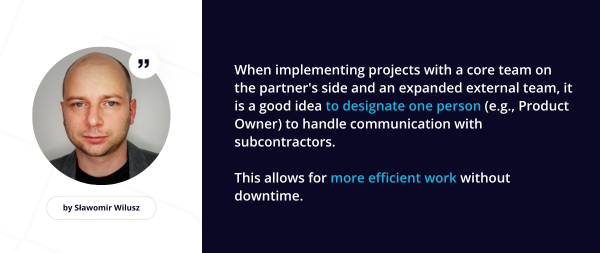From business analysts and UX designers to DevOps and project managers, a modern software team is a mix of experts, each in their field. How can you stop the team from getting too big, pull the project together, and get the product over the finish line?
In this blog post, you will learn:
- What are the common characteristics of a good team?
- What are the methods for implementing technological projects?
- Roles in an IT team – an overview of roles
- Frequently asked questions about roles in IT teams
The size of the technology team dictates the complexity and the way you want to implement the project. You can outsource part or (almost) all the staff, as modern methods of creating digital products rely on body leasing and support from external, distributed subcontractors.
Regardless of the project implementation model, there are several characteristics that define a well-functioning team.
Common Characteristics of a Good Team
Before you familiarize yourself with the individual roles in the team, the key to success lies in:
- Communication and understanding of mutual needs.
- Experience and expertise.
- Engagement.
Starting from the top: good communication does not necessarily have to be equal to the number of hours spent on Zoom during the week. By communication, we mean clearly defined rules of cooperation, scope of responsibilities, selection of appropriate tools, and precise definition of needs and problems.
Communication within the team, whether it is a corporate team or a small startup, is the foundation of good relationships and success. It is even more important when working with external subcontractors.


The second point is the experience of the team. According to startup.com, 23% of startups fail due to lack of specialists. There can be many scenarios, from non-technical project managers, through poorly written specifications, to a team working in a technology that is new to them. Building a team of specialists or supporting it with a dedicated software development team significantly increases the chances of success.
And finally – engagement within the team. It is easier to build engagement among your employees, but much more difficult to demand it from external subcontractors (and there is a chance that you will need exactly that).

Methods for Implementing Technological Projects
In movies, startups go from an idea to a lofty office, a team of several people, and millions of dollars from VC funding in a few scenes. Even if securing funding for a startup doesn’t necessarily have to be difficult, the path from idea to project implementation is, to say the least, winding.
It is worth realizing that:
- You don’t need to have a full team of specialists for a project.
- Support from external specialists is a standard solution for technology companies.
- You can choose between freelancers, body leasing, or dedicated software development teams.

One of the methods for implementing projects is to build a core team supported by an external team. It is up to you who you want to hire internally.

Roles in an IT Team
Here are some crucial roles within a team that we deem necessary for the successful implementation of a project. Each role comes with its own unique set of tasks and skills that contribute to the overall success. Please note, the order in which these roles are listed is completely random!
Business Analyst
A business analyst is a person who translates your vision into measurable goals. The analyst can create clear documentation and base their actions on data. This documentation will be used for project implementation, so in addition to understanding the business, the analyst must also have a profound understanding of the process of creating digital products.
The business analyst works closely with the project team and development team and may also participate in testing. During project implementation, they ensure that it is carried out in line with business goals.
Business analysts are especially necessary in smaller organizations, such as startups, that work with external software development teams. A business analyst can define goals and their feasibility. The specific responsibilities of a business analyst may vary depending on the organization and the specific project.

UX/UI
UX specialists play a key role in translating user needs into features and experiences. They are responsible for research, testing, and design. This position includes people with various skills that enable them to translate user requirements into specific data and design interfaces using tools such as Figma. After implementing the UX design, UX designers gather feedback from users to further improve the product.
The role of the person responsible for UI is slightly different, but in startup environments, one person often manages both areas. UI involves transforming the strong points of UX assumptions into visually appealing, intuitive, and practical interfaces.

Software Developer
Depending on whom you ask, you will hear that they are the only necessary people for software development, and there is some truth to that. The internet is full of memes about front-end and back-end developers, probably made by one group about the other.
In simplified terms: Backend Developers are responsible for building and maintaining the technology needed to power the frontend. They work on servers, databases, and application logic, ensuring smooth communication between the server-side and the client-side. Backend developers are responsible for identifying and fixing bugs, improving system performance, and implementing security measures to protect sensitive data.
Frontend Developers are responsible for creating visual components of applications that users interact with. They design user interfaces, implement design features using CSS, JavaScript, HTML, test and debug issues, optimize applications for speed and scalability, and collaborate with backend developers.
There is also the Fullstack Developer, who combines the skills of both. All of them share programming skills, analytical thinking, and problem-solving abilities.

Tech Lead / Software Architect
A Software Architect or Tech Lead is a person with extensive programming knowledge and experience who makes decisions regarding project implementation (e.g., technology selection, technical requirements) and manages the software development team. The responsibilities of a Tech Lead also include solving technical problems and monitoring production to meet user needs and business goals.
DevOps
DevOps is a software development method that combines development with operations. Within DevOps, there can be several roles, such as DevOps Engineer or DevOps Architect. The roles of DevOps and software architects often overlap, and the scope of responsibilities may vary depending on the organization.
- DevOps Engineers work on automating infrastructure and processes, creating CI/CD pipelines, monitoring system status, and solving issues.
- Software Architects are involved in making high-level decisions, establishing technical standards, including software coding standards, tools, and platforms.
System Administrator
A system administrator in a software development team is responsible for configuring and maintaining a system or server. Their tasks include installing, supporting, and maintaining servers or other systems, as well as planning and responding to service outages and other issues. Administrators perform routine updates and other maintenance tasks to ensure smooth system operation.
Administrators may be involved in scripting or light programming, managing system-related projects, supervising or training, and serving as consultants in case of issues beyond the knowledge of other team members.

Project Manager
The project manager is responsible for planning, organizing, and monitoring project implementation. A PM can work in one or several methodologies (Agile, Scrum, Scumban, Waterfall, etc.), and a good PM can create their own mix tailored to the project. Project managers coordinate collaboration with internal teams and external vendors, ensure resource availability and allocation, identify potential risks, implement risk mitigation strategies, maintain clear communication with all stakeholders, and ensure that the project meets required quality standards.
In small teams, someone in another position may take on the role of project manager. The main goal of a project manager is to deliver the project on time and within the planned budget.

Product Owner
In simple terms, a Product Owner is a project manager working in Agile, which is why Product Owners are often found in the IT industry. The role of a product owner involves understanding stakeholder needs and implementing a specific vision based on those needs.
The product owner works closely with the development team, ensuring that they understand the vision and that the software development process aligns with the business goals.
- Product Owner is a project manager in Agile, often found in the IT industry.
- The role involves understanding stakeholder needs and implementing a specific vision based on those needs.
- The product owner works closely with the development team to ensure alignment between the vision and the software development process.
When developing software with a software house, it is important for the Product Owner to be on the client’s side – this way, one person has control over whether subcontractors are properly implementing the project.
Summary
These are just selected roles in a team. They will vary depending on the complexity of the project, industry, budget, and time frame for implementation. The most essential thing to remember: You can always rely on external specialists!
Frequently Asked Questions
What are the essential roles in a technology team?
You can't do anything without developers, so it is true that you require experienced programmers. However, the roles of UX/UI designers, business analysts, and system administrators should not be underestimated.
I lack IT specialists. How can I support my team?
Of course! Depending on your needs, you can use body leasing or a dedicated software development team.
What is the biggest risk in software development?
If we had to choose one, project failure due to running out of time or budget seems to be the biggest risk. You can minimize this risk by preparing well for project implementation (excellent specifications, budget planning, realistic implementation plan, support from specialists).






